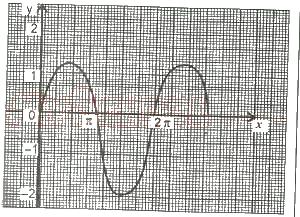50√3m
25√3m
25√3m/3
25m/3
√3m/25
Correct answer is C
No explanation has been provided for this answer.
Given that sin \(\theta\) = -0.9063, where O \(\leq\) \(\theta\) \(\leq\) 270°, find \(\theta\).
65o
115o
145o
245o
265o
Correct answer is D
Sin\(\theta\) = -0.9063; \(\theta\) = sin-1(0.9063)
\(\theta\) = -64.99 = -65°
\(\theta\) = 180° - (-65);
180 + 65 = 245°

the graph above is a sketch of
y = sin 2x
y=sinx
y=cos2x
y=2sinx
y = 2cos x
Correct answer is D
No explanation has been provided for this answer.
2πR cos4o
πR sin40o
Correct answer is D
Angular distance = 40o + 20o = 60o
using θ/360 x 2πr for distance between p and Q
= 60/360 x 2πRcos4o = 1/3πRcos4o
3
6
45
48
90
Correct answer is D
a = 1st term ; ar4 = 5th term
∴ ar4 = a(2)4 = 16a; 16a = 45 + a, a = 3;
3(2)4 = 48
WAEC Subjects
Aptitude Tests